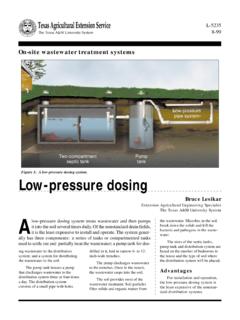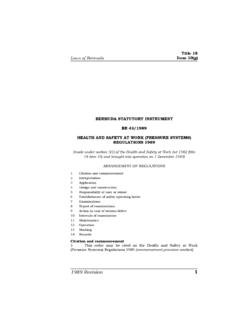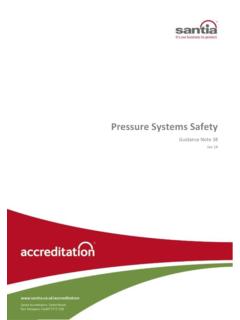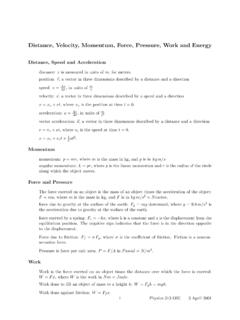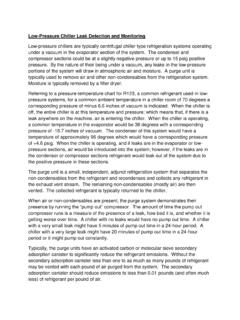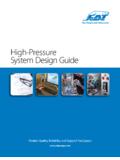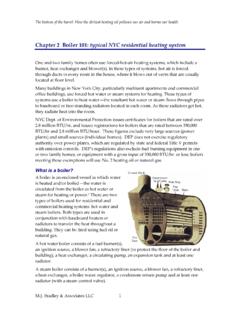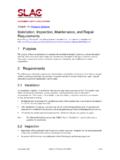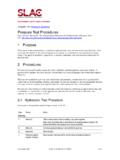Transcription of A guide to the Work in Compressed Air Regulations 1996
1 Page 1 of 86 Health and Safety ExecutiveHSE BooksThis is a free-to-download, web-friendly version of L96, (First edition, published 1996, reprinted 2002). This version has been adapted for online use from HSE s current printed version. You can buy the book at and most good bookshops. ISBN 978 0 7176 1120 1 Price guide looks at the work in Compressed Air Regulations 1996 and addresses such issues as safe systems of work , medical surveillance, compression and decompression procedures, medical treatment, emergency procedures, fire precautions and instructions and provides a framework for the management of health and safety by those undertaking tunnelling and other construction work in Compressed guide to the work in Compressed Air Regulations 1996 Guidance on Regulations Page 2 of 86 Health and Safety Executive Crown copyright 1996 First published 1996 Reprinted 2002 ISBN 978 0 7176 1120 1 All rights reserved.
2 No part of this publication may be reproduced, stored in a retrieval system , or transmitted in any form or by any means (electronic, mechanical, photocopying, recording or otherwise) without the prior written permission of the copyright for reproduction should be made in writing to: The Office of Public Sector Information, Information Policy Team, Kew, Richmond, Surrey TW9 4DU or e-mail: Code has been approved by the Health and Safety Executive, with the consent of the Secretary of State. It gives practical advice on how to comply with the law. If you follow the advice you will be doing enough to comply with the law in respect of those specific matters on which the Code gives advice. You may use alternative methods to those set out in the Code in order to comply with the law.
3 However, the Code has a special legal status. If you are prosecuted for breach of health and safety law, and it is proved that you did not follow the relevant provisions of the Code, you will need to show that you have complied with the law in some other way or a Court will find you at fault. work with display screen equipment Page 3 of 86 Health and Safety ExecutiveContentsIntroduction 7 Regulation 1 Citation and commencement 9 Regulation 2 Interpretation 9 Regulation 3 Application 10 Scope of the Regulations 10 Regulation 4 Duties 10 Regulation 5 Appointment of Compressed air contractor 11 Regulation 6 Notifications 11 Who to notify 12 Hospitals 12 Suspension and completion of work 12 Regulation 7 Safe system of work 13 Competent persons 13 Person in charge 14 Compressor attendant 14 Lock attendant 15 Medical lock attendant 15 Regulation 8 Plant and equipment 16 Power supply 18 Air supply.
4 Plant etc 18 Supply of air 18 Air pipelines 19 Temperature in the working chamber 20 Airlocks - general requirements 20 Manlocks - general requirements 20 Horizontal locks 21 Combined locks 21 Vertical locks 21 Airdecks 22 Valves, controls and gauges 22 Lock attendant s station 23 Emergency lighting 23 Communications systems 24 Regulation 9 Appointment of contract medical adviser 24 Regulation 10 Medical surveillance 26 Health risks 27A guide to the work in Compressed Air Regulations 1996 Page 4 of 86 Health and Safety ExecutiveGeneral duty on employers to make arrangements for medical surveillance 28 Role of the appointed doctor 28 Content of medical examinations 28 Assessment of continuing fitness for work 28 Other medical examinations 29 Health record 29 work restrictions specified in the health record 30 Availability of medical records 30 Maintenance of Compressed air worker s health and exposure record 30 Duty to submit to medical surveillance 31
5 Regulation 11 Compression and decompression procedures 31 Compression 32 Acclimatisation 33 Limits of exposure, including multiple exposures 33 Decompression 34 Emergency decanting 34 Keeping of decompression records 35 Regulation 12 Medical treatment 35 Medical locks 36 Use of the medical lock 36 Provision of adequate facilities 36 Recompression therapy 38 Regulation 13 Emergencies 39 Access and egress 39 Emergency procedures in the health and safety plan 39 Fire 40 Regulation 14 Precautions against fire 40 Regulation 15 Information, instruction and training 41 Regulation 16 Fitness for work 42 Regulation 17 Intoxicating liquor and drugs 43 Prohibition of alcohol 44 Prohibition of drugs 44 Regulation 18 Welfare 44 Sanitary conveniences and washing facilities 45 Facilities for remaining on site etc 45 Food and drinks during recompression therapy 45 Regulation 19 Badge, label or other device 45 Regulation 20 Defence in proceedings 46A guide to the work in Compressed Air Regulations 1996 Page 5 of 86 Health and Safety ExecutiveRegulation 21 Power to grant exemption 46 Regulation 22 Revocations and modification 46 Schedule 1 Information to be contained in a notice given pursuant to regulation 6(1), 6(2) or 6(3)
6 47 Schedule 2 Revocations and modification 48 Appendix 1 Application of the pressure Systems and Transportable Gas Containers Regulations 1989 49 Appendix 2 Use of portable electronic atmospheric gas monitoring equipment in Compressed air workings 50 Appendix 3 Types of airlock 51 Appendix 4 The role of the contract medical adviser 53 Appendix 5 Reporting of hyperbaric illnesses under RIDDOR 55 Appendix 6 Outline syllabus for a course in hyperbaric medicine relevant to work in Compressed air 56 Appendix 7 Medical examinations 58 Appendix 8 Radiology 62 Appendix 9 Compression and decompression procedures approved by the Health and SafetyExecutive 65 Appendix 10 Diagnosis, recording and evaluation of decompression illness 69 Appendix 11 Decompression illness initial assessment checklist 74 Appendix 12 Therapeutic recompression 76 Appendix 13 Use of high pressure oxygen 78 Appendix 14 Access to and egress from the working chamber 80A guide to the work in Compressed Air Regulations 1996 Page 6 of 86 Health and Safety ExecutiveAppendix 15 Selection and use of self-rescuers and breathing apparatus in Compressed air workings 81 Appendix 16 Record-keeping 82 Appendix 17 Summary of principal changes in requirements with increasing pressure 85 Further information 86A guide to the work in Compressed Air Regulations 1996 Page 7 of 86 Health and Safety ExecutiveIntroduction1 The work in Compressed Air
7 Regulations 1996 (SI 1996/1656) provide a framework for the management of health and safety risks by those undertaking tunnelling and other construction work in Compressed air. They essentially update the work in Compressed Air Special Regulations 1958. They also amplify general duties under the Health and Safety at work etc Act 1974 and the Management of Health and Safety at work Regulations 1992. 2 The work in Compressed Air Regulations 1996 address such issues as: safe systems of work ; medical surveillance; compression and decompression procedures (including HSE approval of procedures); medical treatment; emergency procedures; fire precautions; provision of information, instruction and training; and maintenance of health and exposure records.
8 Many of the duties are placed upon Compressed air contractors to reflect the practical operation of the industry and in recognition of the fact that the contractor in charge of the Compressed air operations is best placed to manage and control the health and safety risks of such The coverage of the Regulations is limited to the construction industry, excluding such areas of work as diving, hyperbaric medicine (except for applications relating to construction work in Compressed air) and clean rooms. The lower limiting pressure of bar has been set to exclude work at very low pressures where the risk of decompression illness is Wherever work is carried out in Compressed air, the provisions of the Construction (Design and Management) Regulations 1994 will apply because the number of people required to carry out and manage such work will bring it within the applications of those Regulations .
9 For most, but not necessarily all, Compressed air projects the Compressed air contractor will be the principal contractor under the Construction (Design and Management) The Construction (Health, Safety and Welfare) Regulations 1996 also apply to Compressed air projects, with the work in Compressed Air Regulations providing additional standards because of the particular risks and conditions involved in work in Compressed air. The additional requirements relate to emergencies, fire precautions and risks associated with work in Compressed air6 There are three types of health problem which can be brought about by working in Compressed air: (a) barotrauma, where a change in surrounding pressure causes direct damage to air-containing cavities in the body directly connected with the surrounding atmosphere, principally ears, sinuses and lungs;(b) decompression illness, which predominantly occurs as a condition involving pain around the joints, or, more rarely, as a serious, potentially life-threatening condition which may affect the central nervous system , the heart or the lungs.
10 And(c) dysbaric osteonecrosis, which is a long-term, chronic condition damaging the long bones, hip or shoulder Methods of complying with the work in Compressed Air Regulations are, in some cases, prescribed by the Regulations . This guidance gives further advice on how to comply with the law and is divided into sections corresponding with each individual regulation (reproduced in italics). Detailed advice on technical and medical aspects of work in Compressed air is mainly contained in the appendices. This A guide to the work in Compressed Air Regulations 1996 Page 8 of 86 Health and Safety Executiveguidance has been prepared by HSE after widespread consultation with employers, trade unions, professional bodies and medical guide to the work in Compressed Air Regulations 1996 Page 9 of 86 Health and Safety ExecutiveRegulation 1 Citation and commencementThese Regulations may be cited as the work in Compressed Air Regulations 1996 and shall come into force on 16th September 2 Interpretation (1) In these Regulations , unless the context otherwise requires - the 1996 Regulations means the Construction (Health, Safety and Welfare) Regulations 1996(a).











